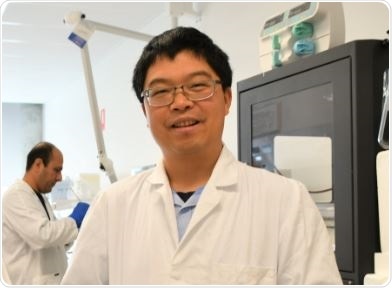A novel way to pinpoint and illuminate bone damage promises to make X-rays more efficient at diagnosing bone and other injuries, Flinders University researchers say.

Image Credit: Flinders University
The new technique, looking at potential biomedical applications of an ancient inorganic salt-based aggregation induced emission (AIE) radio-luminescence material, could open new frontiers in medicine including X-ray dosimetry, bioimaging and advanced applications such as optogenetics, says Professor Youhong Tang, from Flinders University's College of Science and Engineering.
The review article, published by Professor Tang, postdoctoral student Dr Javad Tavokoli, colleagues in Hong Kong and Australian technology company Micro-X and, examined the potential of the AIEgen luminogens (AIEgens) in deep tissue imaging. The study used X-ray testing provided by Adelaide-based Micro-X.
"We were able to use Micro-X advanced X-ray machines at the Tonsley Innovation District to show the benefits of this AIEgen system which can be excited by X-ray (as the radioluminescence emitter) and UV light (as the photoluminescence emitter) compared to current AIEgens which mostly only act as the photoluminescence emitter," he says.
The study highlighted the disadvantages of autofluorescence, poor signal-to-noise radio, and poor tissue penetration depth of traditional photoluminescence emitters which could be elegantly solved by these radioluminescence luminogens. Not only do they pinpoint bone and soft tissue damage for better diagnosis and treatment but we suggest further studies could see these AIE-based materials with multifunctionalities used for improved drug delivery, biosensors, bioimaging, and tissue engineering."
Youhong Tang, Professor of Mechanical and Materials Engineering, Flinders University
Lead author on the journal article in Aggregate, Dr Tavokoli, how based at the Centre for Health Technologies at University of Technology Sydney, says the next generation of fluorescent gels could also capitalise on additional light-emitting properties making them attractive for different applications.
The latest work not only explores a series of inorganic AIE systems but also "fundamentally helps to understand both the unconventional organic and inorganic clusteroluminescence phenomena, Professor Tang concludes.
Source:
Journal reference:
Zhao, Z., et al. (2021) Revisiting an ancient inorganic aggregation‐induced emission system: An enlightenment to clusteroluminescence. Aggregate. doi.org/10.1002/agt2.36.